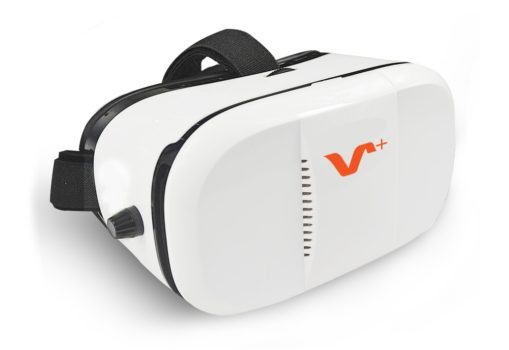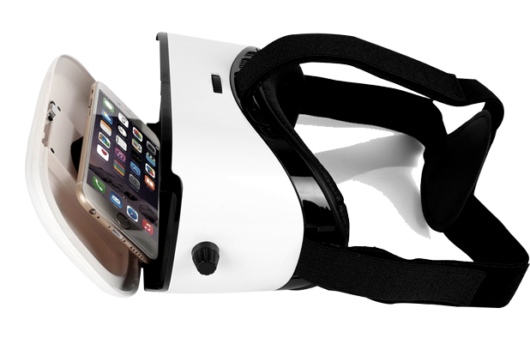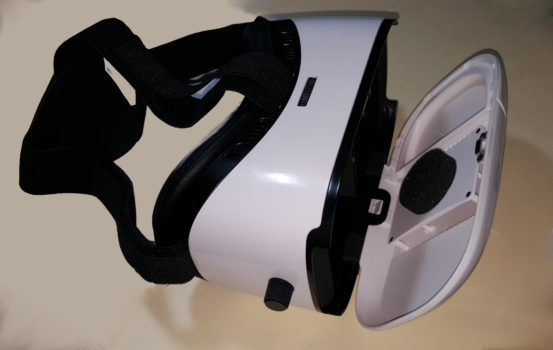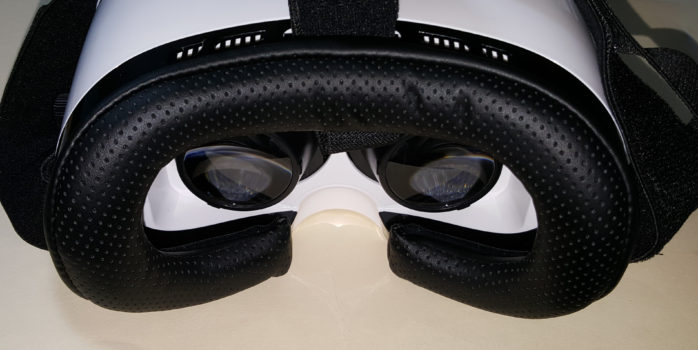Disclosure: The folks at Vox VR just sent me a free review copy of their Vox+ Z3 headset, which is a rebranded version of the BoboVR Z3 but with a larger field of view. Thanks, guys! The purchase links at the bottom of this article are to all the major sites I know that carry it, with affiliate links where available.
Bottom line:Â This headset, while not my all-time favorite, is still a great buy. Light-weight, easy-to-use, adjustable lenses, and with an industry-leading 120 degree field of view.

1. Field of view
The field of view is officially listed as 120 degrees, which is the same as the BoboVR Z4, and is currently the best on the market. Unfortunately, you only get the full effect of this wide field of view with a large smartphone screen. My phone, a Samsung Galaxy S5, at 5.1 inches, was actually too small — I was able to see the edges of my smartphone in the periphery of my vision.
And I don’t have anyone around with a larger phone to try it out with.
However, the graphics are super crisp and clear, and I have a feeling it will look great. And once you get into the game or video you’re watching, you stop noticing the edges.
However, if you have a phone with a screen that’s 5.1 inches or less, you may want to choose a different headset.
This is a nasty Catch-22 situation for viewer manufacturers, by the way. Either you cut off the edges of the phone, or you have too much of the phone in your field of view. Maybe they’ll come out with some kind of adjustable mechanism to deal with this.
2. Weight
This headset weighs around 300 grams, or about 10.5 ounces. That’s a pretty lightweight set. By comparison, the Samsung Gear VR is 12 ounces. But it’s not the lightest enclosed headset around — the FiiT VR 2S, my current favorite, is about 9 ounces, and the super-tiny Leji VR Mini is just 7 ounces.
3. Straps
Usual straps that go around the sides and over the top of the head. No complains, just the standard straps. My headset came with the straps already attached, which was nice.

4. Fits over glasses
Nope. Glasses do not fit.
5. Adjustable lenses
There’s a little dial at the top of the headset that moves the lenses further apart and closer together. The two knobs on the sides adjust the focus.

6. Ready for augmented reality
Part of the outside cover slides off, so that the phone’s camera can see out for augmented reality applications. However, this means that it’s easy to lose a section of the front cover.
7. Fits over audio and power cables
There are gaps on the sides allow for power and audio cables.
8. Controller
There is no control button on the headset, Plus, mine did not come with an external controller, and you will need one if you use apps that require you to use a button. Keep in mind that there’s no Bluetooth controller that currently works with iPhones. So you will either need to use an Android phone with this, or stick with apps that use a look-to-activate mechanism.
9. Ease of use
The outside cover flips open easily, and the smartphone drops down onto a little shelf. Spongy material holds it in place. The cover is held in place with a magnetic latch.
I like this mechanism a lot. Out of all the various approaches I’ve seen to holding a smartphone in place, this is the style I like best. It’s easy to use, the phone is easy to adjust, it stays in place, and it’s gentle on the phone’s cover.

I found the padding to be nice and comfortable, but some people might not like the fact that it does not extend over the nose.
This headset also come with a Google Cardboard QR Code, which is excellent. Instructions for how to use it are here.
However, the Google Cardboard QR Code was in the little manual that came with the headset, not on the headset itself. The QR Code that’s on a sticker on the side of the headset just goes to the company website.
If you lose it, here it is again:
10. Price
As I mentioned above, mine was free, but it’s normally $24 on Amazon.
- OSgrid back online after extended maintenance - April 16, 2025
- Analysts predict drop in headset sales this year - March 25, 2025
- OSgrid enters immediate long-term maintenance - March 5, 2025

